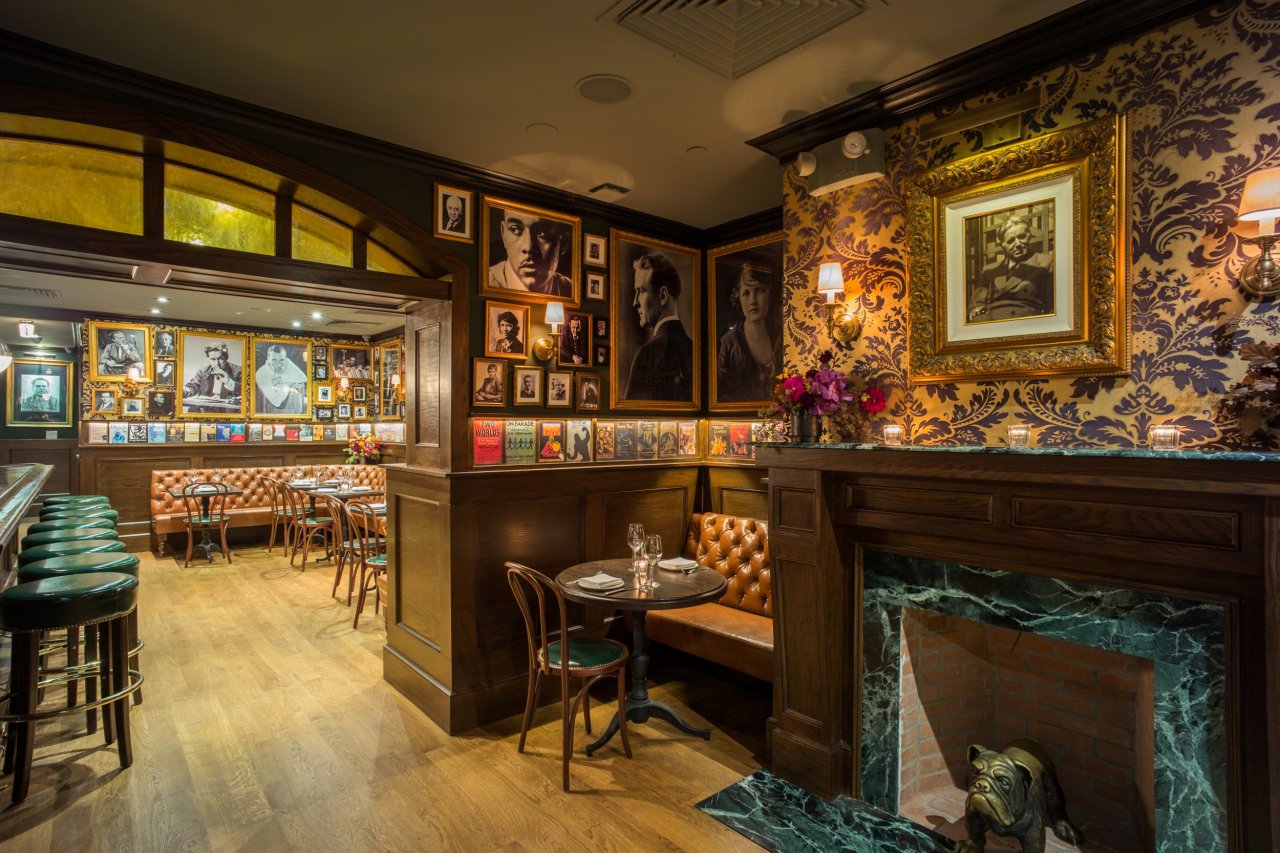I was ready to hate the new Chumley's. The old Chumley's was the Greenwich Village speakeasy squeezed into a Bedford Street rowhouse that was visited by Hemingway, Steinbeck, Cather, Faulkner and just about every other writer you read in high school and tried to emulate in college. When I discovered it in the very early 2000s, it seemed to me far more interesting than the self-consciously literary bars and cafés drawing New York City's ambitious and bespectacled to Park Slope and the East Village.
Chumley's was too old and too small for any such pretensions. Though the dust jackets of its famous patrons' famous books adorned the walls, it had become a bar for local firefighters, as well as for the kind of refreshingly ordinary people New York had steadily been pushing out in the name of progress. There was a secret entrance, down Barrow Street and through Pamela Court, and leading friends through the haunting, nearly sacral silence of the courtyard, into the beery warmth that awaited inside Lee Chumley's famous cave suggested you were in the know, privy to some secret Greenwich Village not yet turned over to Stella McCartney and Marc Jacobs. The burger came inside an English muffin, and it was beautiful.
Then a wall collapsed in 2007. This was a calamity but not a surprise, since Chumley's—birthed two years into Prohibition, i.e. 1922—had always been something of an ancient grotto with surprisingly functional tap lines. The surprise, a deeply unwelcome one, came in the years that followed, as Chumley's struggled and failed to reopen. There was something about permits, and then something about the neighbors—always something. What what was happening on Bedford Street was happening elsewhere around New York City: rising condos, rising prices. In 2006, the Village lost the Cedar Tavern, famed haunt of Pollock and Rothko and the great postwar painters, because the building was being turned into a condo. Elaine Kaufman died in 2010, and Elaine's, immortalized by Tom Wolfe in The Bonfire of the Vanities and visited by every writer of note who wanted a martini and fame and then another martini, went into oblivion the next year. The Bridge Cafe, New York's oldest tavern, suffered extensive damage during Superstorm Sandy in 2012. Over four years later, it remains closed. The great working-class taverns of the Upper West Side—the P&G, the All State—also went to great real estate broker in the sky.
It seemed possible that Chumley's would never open again.
Then, in the summer of 2016, The New York Times reported that Chumley's owner Miller had entered into a compact with Alessandro Borgognone, who was going to open and operate Chumley's for him. Borgognone was recently made famous by the opening of the celebrated Sushi Nakazawa, where dinner may run $150, nearly three times what Bob Dylan paid in monthly rent to live on West Fourth Street in 1961.
I was not thrilled by this development. Borgognone seemed to me the kind of slick carpetbagger for whom New York was nothing but a collection of "gritty" tropes to be used in marketing materials. His admission in the Times that he'd never been to the old Chumley's was an admission, to my mind, that he did not know New York. His assertion that the new Chumley's was going to be "Chumley's on steroids" was both puzzling and troubling, as steroidal is a trait one generally wants to avoid in both hamburgers and people.
I posted the Times article to Twitter with the following comment: "With imposters like this in charge, Chumley's might as well stay closed."
But Chumley's did open this past fall, and on a blustery December night doing its best imitation of Antarctica, I finally did visit. With me was Newsweek colleague Josh Saul—like me a former tabloid man, like me a patron of the original bar. We went in hunger and in skepticism, in the name of journalism and good old New York.
First impression: We're not in 1976 anymore. The new Chumley's is run by young, attractive people, primarily for others of their ilk. The place is smaller and darker, but the book jackets remain on the walls, as do the photographs of firefighters.
"It's smaller," I said of the restaurant as we sat down at our wooden table.
"Nah," said Saul. "It's exactly the same."
I was right. Kate Krader of Bloomberg Pursuits reported that "because the collapse destroyed so much, Chumley's dining room has shrunk at least 10 percent, both in height and width." And according to my calculations, the patrons are 34 percent younger and 57 percent more attractive, the cocktails 75 percent more innovative, the food 184 percent more expensive, the "secret" Pamela Court entrance 100 percent more inaccessible. One of the old tables—unvarnished wood with names scratched into its face—sits behind glass in the bathroom, like some ancient relic.
What were going to eat? The burger, of course. "The burger is bound to be the breakout star," wrote John Lockett in GQ , as if discussing basketball prospects. Its particulars have been noted with reverence: two patties, slathered in bone marrow and crispy shallots, costing $25.
The tables at Chumley's are close together, and some crosstalk seems unavoidable. So when the two fashionable women at the next table heard us discussing the menu, they offered their opinion: This was the best burger in town. At the next table dined a young man with his father. The father, mustachioed, wrote screenplays, while the young man had recently photographed Chumley's for a New Yorker review. He also praised the burger. When I suggested that the burger at the nearby Corner Bistro perhaps remained the best in town, I was roundly mocked like one of those old timers who insists there hasn't been good baseball in New York since the Dodgers left Brooklyn.
It is odd to lead with food, not alcohol, in writing about a place most famous for serving booze. I don't remember if the original Chumley's had spirits, because I don't think I ever drank anything other than beer there, but center stage now belongs to cocktails, which are like the rest of Manhattan in this Year of Our Lord 2016: wonderful and expensive. Just a Little Drink ("12 yr old demerara rum, amber agricole rhum, pommeaux, china, angostura, orange bitters, absinthe") was an excellent bulwark against the cold waiting outside. It cost $16, as does every one of the creative cocktails on the menu. At least one bottle of red wine was $400.
On the same day Saul and I visited Chumley's, ProPublica published an article about "the gradual dismantling of New York's system of rent stabilization," which began with a 1994 vote in the City Council on "vacancy decontrol." The real estate industry won, and middle-class people lost, as median rent in Manhattan is an astonishing $4,000. In 1994, it was possible to rent a studio for about $400. Commercial rents have followed suit. The choice, in other words, was not between the old Chumley's and the new Chumley's; it was between the new Chumley's and a Chipotle.
Apparently, at least some of the old-timers have made peace with the new joint, as I have. "We have people in this establishment, the new Chumley's, who frequented the former Chumley's almost every night, if not every night," says Borgognone. "All of them leave happy."
Saul, my colleague and dining companion, may not have been a regular of the old place, but he did leave the new place happy. "Chumley's has grown up," he wrote to me a couple days after our visit. "The first time I stepped through the red velvet curtain 11 years ago I was a broke college kid on a first date, happy to find a cheap shepherd's pie. The new Chumley's is shinier and more expensive, but just like its predecessor it transports you with its light and conversation, makes you feel like Dreiser and Steinbeck are just a table away. Chumley's grew up, lost some of its grit and put on a jacket. Just like a lot of New York. And, I guess, just like me."
That's probably for the best. A quick search of The New York Times quickly dispels any romantic illusions about the city of grit in which the old Chumley's thrived. In 1960, a writer was killed at Chumley's by a sailor wielding a beer bottle, angry over a chess match. Four years later, a sculptor leaving Chumley's was shot in an attempted mugging. In 1974, a heroin addict who'd killed a Macy's copywriter was found hiding in Chumley's boiler room. Even greater ills awaited. An article from 1986 on the "hidden charms of the West Village" notes that "the AIDS epidemic has closed a number of West Street clubs and recently led to the opening of a hospice at St. Veronica's Church"—and the worst of it hadn't even come yet.
We grow up, and so do the cities where we live and have lived. Some call this gentrification, but often that's just a cheap excuse for what time does to the rich and poor alike. You were once single, out until 4 a.m., and now you're reading Olivia Forms a Band to your preschooler. There was once a Chumley's, and then there wasn't a Chumley's; and then all of a sudden, there was a new Chumley's, at once identical to and utterly unlike its predecessor. Time can only move forward, even down the crooked streets of the West Village. Drink a beer, eat a burger and rejoice.




















